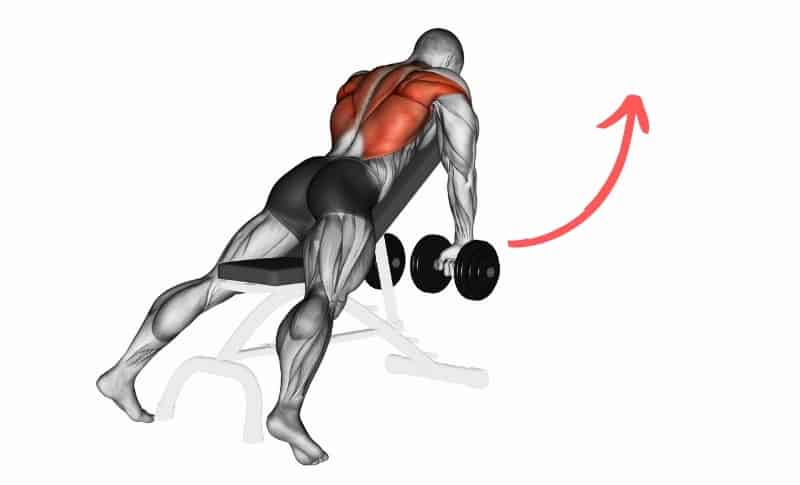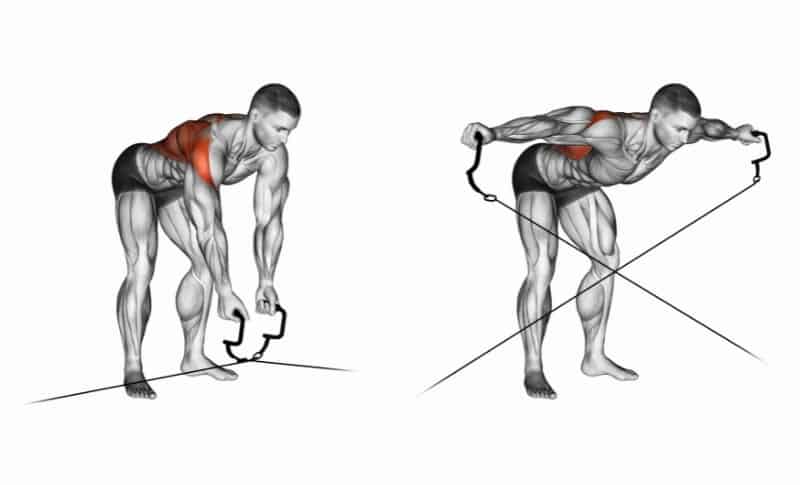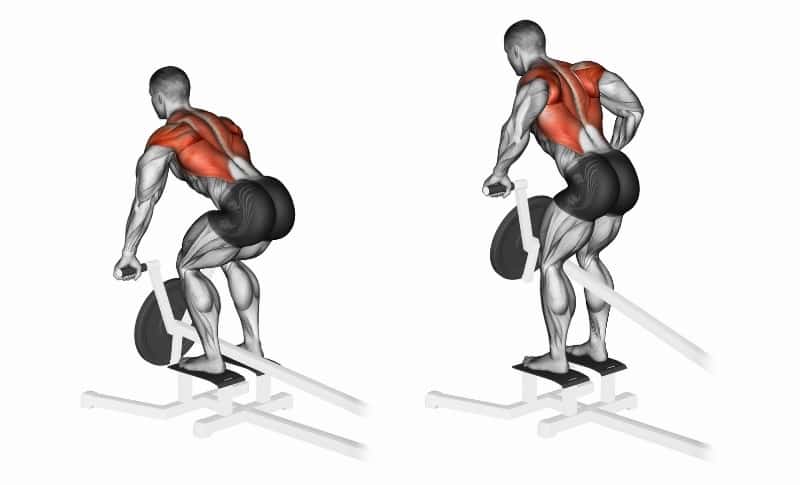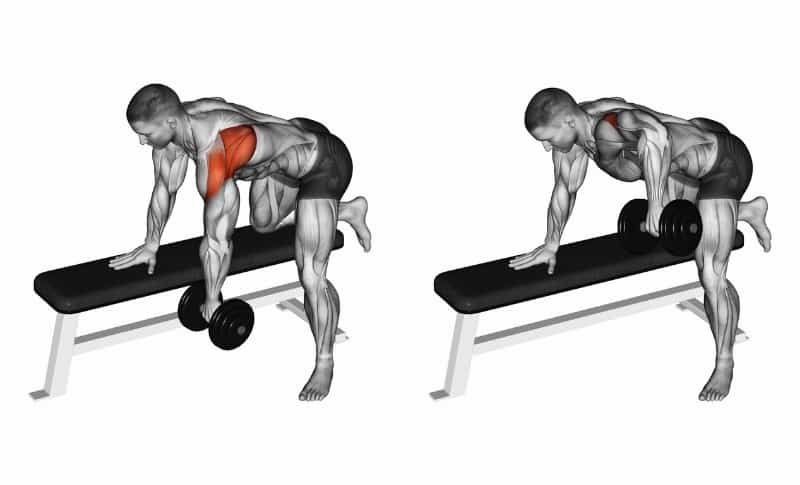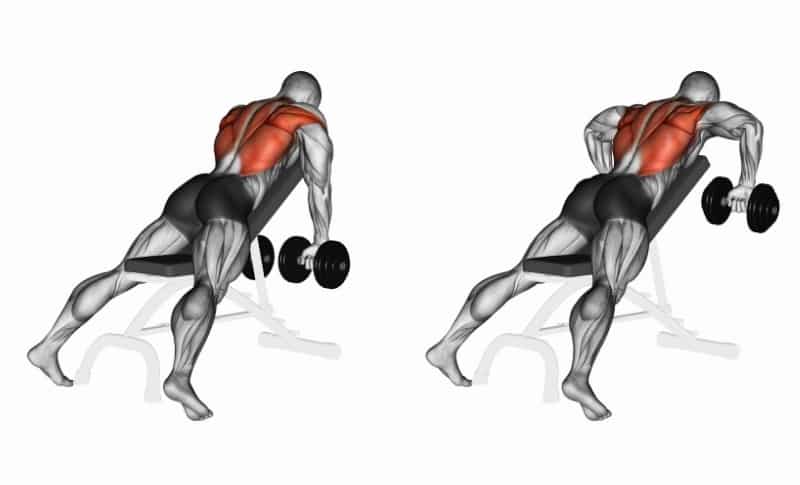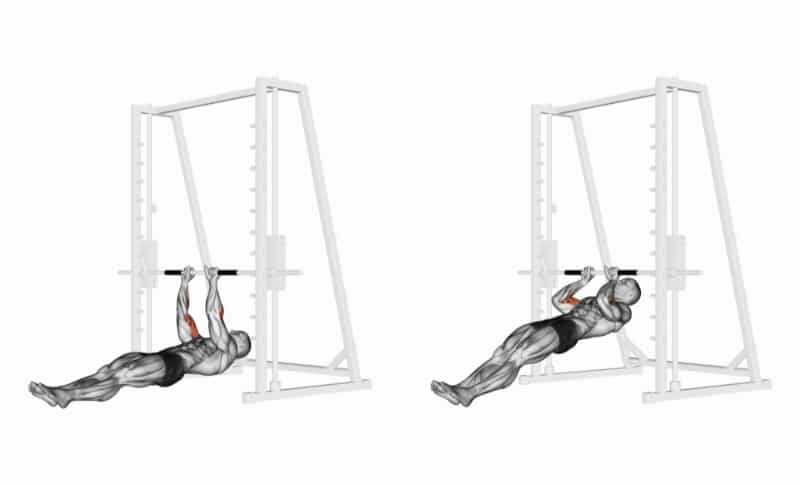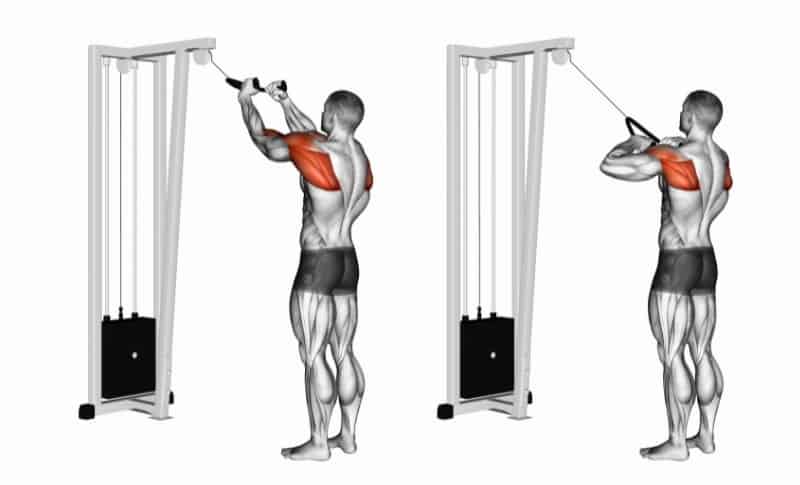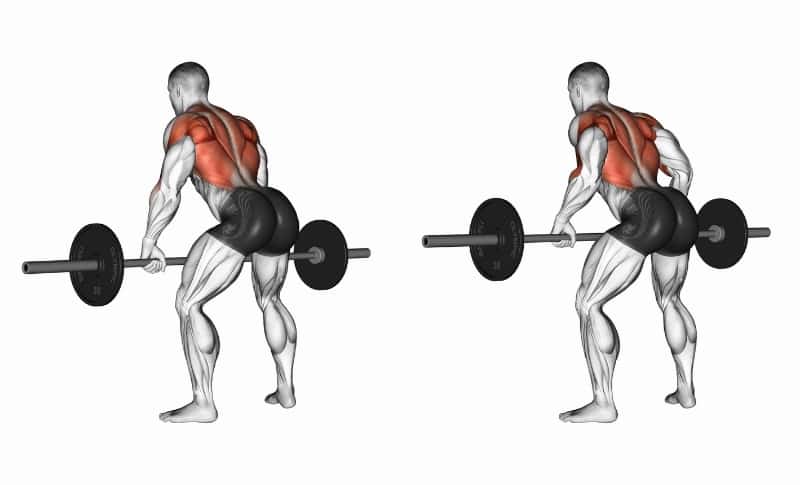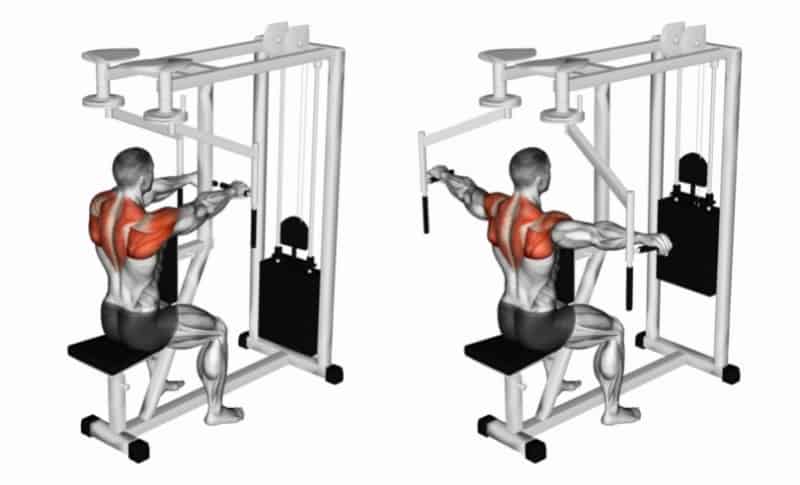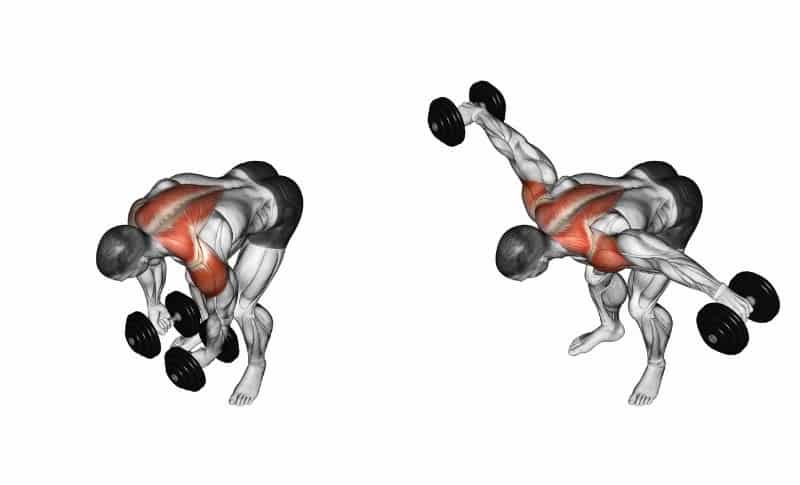Training
The 10 Best Rear Delt Exercises
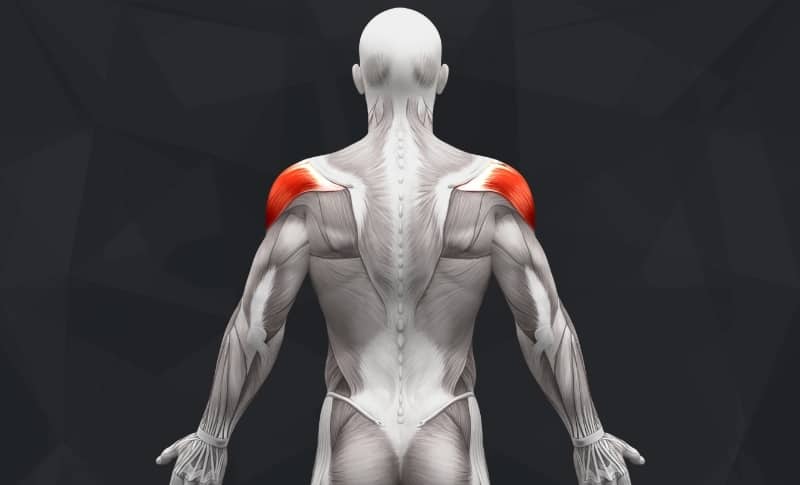
What are the best rear delt exercises?
The best rear delt exercises are essential for developing strong and stable shoulders with great definition.
They also help improve posture by providing additional support for your back muscles, as well as assisting with core stability.
This guide to the best rear deltoid exercises breaks down which ones work best for different desired outcomes.
The Best Rear Delt Exercises
Our exercise lists are created by determining the best exercises for muscle growth, core strength, and overall health and well-being.
Here’s our list of the 10 best rear delt exercises:
10. Incline Dumbbell Y-Raises
Note: We were unable to get a complete illustration of the finished position. However, the starting position is as above.
Great for:
Incline dumbbell Y-raises are an excellent way to build strength and flexibility in your rear delts.
This exercise also works your forearms and chest muscles, making it an effective technique to employ when developing your upper body strength.
How to do it:
Take a bench with the back up at around 45-degrees, then:
- Lie on the bench on your front with your head over the top of the back rest
- Use your feet to support your weight on your toes, holding the dumbbells directly beneath your shoulders
- Slowly raise the dumbbells until they are over your head in a Y-shape
- As you perform this movement, engage your core and pull your shoulder blades forwards
- After a brief pause, return the dumbbells down to the starting position
Why:
As well as building strength and definition in your shoulders, incline dumbbell Y-raises also improve shoulder mobility.
Posture also benefits from this exercise, as well as improving overall upper body definition through sculpting your shoulders and lifting up the pectorals.
When:
Include this exercise as part of your upper body workout sessions or as part of a session dedicated to your shoulders, aiming for 2-3 times per week.
9. Standing Reverse Cable Flyes
Great for:
One of the great posterior deltoid exercises at the rear of your shoulders, standing reverse cable flyes, belongs in your upper body repertoire.
They also work out the rhomboids and trapezius in the upper back to help with overall upper body definition.
How to do it:
Stand between two cables on the cable machine with the pulleys set at the top position, then:
- With your legs shoulder-width apart, take the pulley grip from the left cable in your right hand and the grip from the right cable in your left hand, pulling them across one another so the cables form a cross in front of your chest
- With a soft bend in the knees and elbows slightly bent, pull the handles outwards until your arms are nearly outstretched
- Slowly return the cables to the central position
Why:
Standing reverse cable flyes are a great way to build a nice, rounded shoulder area, particularly the side and rear portions.
It also helps to build mobility and stability in your shoulder girdle and rotator cuff muscles, making other shoulder-related workouts easier and safer to perform.
When:
When working out your shoulders and upper body, include this exercise, and increase the weights over time as your performance improves.
8. T-Bar Rows
Great for:
The T-bar row hits a range of muscles and works towards building good core strength.
In addition to the posterior deltoid, other muscles engaged by this exercise include the rhomboids, trapezius, and latissimus dorsi.
How to do it:
Plate up a barbell on one end and support the other end against the wall or another immovable object, then:
- Bend over the end of the bar near to the weight and take it with a V-grip handle in both hands
- Maintaining a neutral arch in your lower back, squeeze your shoulder blades together and lift the bar, so the plate touches your chest
- Slowly lower back down to the starting position, keeping your back and shoulders engaged with the motion
Why:
The bent-over barbell row might be a great exercise for building strength throughout the upper back, but it’s also one with a high risk of back injury.
Perform the T-bar row exercise as a safer alternative, and still build up muscle mass and strength in your back and shoulders.
When:
This is a fantastic exercise to include in your upper body workout sessions or during workouts dedicated to building up your back and shoulders.
7. Dumbbell Single-Arm Bent-Over Rows
Note: The difference between this exercise and a normal single-arm dumbbell row is the position of the dumbbell and the alignment of the elbow as you reach the top of the movement. Driving the elbow straight up will target the rear delts more than the back.
Great for:
The dumbbell single-arm bent-over row is perhaps the best rear deltoid exercise to include in any upper body workout since they hit the lower back, biceps, hips, and shoulders.
This exercise also improves all-around core stability, helping to develop a better overall posture.
How to do it:
Take a flat exercise bench and a single dumbbell of the weight of your choice, then:
- Place your right hand and right knee on the bench
- Bend over so your upper body is parallel with the ground, and hold the dumbbell in your left hand, directly below your shoulder
- Lift the dumbbell to your chest, using your shoulders and back to drive the motion and keep your chest still
- Pause at the top, squeezing your back and shoulder muscles
- Slowly lower the weight back down until your arm is extended
- After performing the desired reps with this arm, switch to the other arm and repeat
Why:
Dumbbell single-arm bent-over rows will work your latissimus dorsi, biceps, trapezius, and rhomboids.
This means you’ll develop a strong back, as well as build strength and definition in your shoulders.
When:
Try aiming for 6-8 reps over 3-5 sets, including this exercise in your workout routines 2-3 times per week.
6. Incline Rear Delt Dumbbell Rows
Great for:
This great rear delt exercise can be performed with the same incline bench set-up used for the incline dumbbell Y-raises.
This workout also hits a range of back muscles to help strengthen your spine, with a primary focus on your rear delts to lift the weights.
How to do it:
With the bench backrest up in an incline position:
- Lie face front on the bench, propping up your body on your toes
- Hold a dumbbell in each hand, extending your arms out in front of you
- Slowly lift the dumbbells towards your body until your elbows are slightly above your shoulders
- Hold for a second, squeezing your shoulder and back muscles
- Return the dumbbells down to the starting position, then repeat for additional reps
Why:
This rear delt exercise works the deltoids and the latissimus dorsi, rhomboid, and trapezius muscles for a broader upper body workout.
It’ll also help to build flexibility in your shoulder joints and increase your range of motion in this area.
When:
Perform 3-5 sets with reps ranging from 10-15 per set, and include it 2-3 times per week when exercising your upper body and shoulders.
5. Wide Grip Inverted Rows
Note: The illustration above shows a close grip inverted row, which targets the biceps more than the delts. Switch to a wider grip to target the rear delts properly.
Great for:
If you’re a fitness newbie and want to begin with an easy and safe exercise for rear delts, wide grip inverted rows come highly recommended.
As well as working the shoulder muscles, this rear delt workout delivers the goods throughout the upper body while also recruiting muscles in the legs.
How to do it:
To perform this exercise, place a barbell on a weight rack approximately waist height, then:
- Lie on the ground facing up and take the bar in both hands with an overhand grip at shoulder-width apart
- Keeping your body in a straight line, contract your abs and glutes, then pull your body up towards the bar until your chest touches it
- Lower yourself back down to the floor in a controlled motion
Why:
Wide grip inverted rows are much easier to perform than traditional pull-ups, making it one of the very best rear delt exercises for all proficiency levels.
In addition to promoting strength across a range of muscles, they also boost grip strength and help develop a tighter core.
When:
Include this great rear delt exercise as part of your upper body or even full-body workouts, and you’ll start noticing results in just a few sessions.
4. Rope Face Pulls
Note: The illustration above shows the rope being pulled from a higher position to the chest muscles. To concentrate on the rear delts, lower the height of the cable slightly and pull the rope towards your face.
Great for:
This is an effective upper body exercise that targets your rear delts and assists with increased mobility in your shoulder joints.
It’s also a good way to increase your form and effectiveness in a range of other exercises by improving upper body flexibility.
How to do it:
Set the cable pulley to the highest position on the cable machine and hook on a double-rope attachment, then:
- Grasp the handles in an overhand grip with your palms facing the floor
- Pull your arms towards you, finishing when your hands are at the sides of your head
- Return to the starting position, maintaining tension throughout this motion
Why:
As well as working your rear delts, the rope face pull exercise activates muscles in your upper back, such as the trapezius and rhomboids.
They can also improve your overall posture, making them essential for people who spend much of their day sitting at a desk.
When:
If you’re working on building upper body strength, and want to give your shoulders a broader appearance, try performing rope face pulls 2-3 times per week.
3. Barbell Bent-Over Rows
Great for:
Ensuring you get the form right for the barbell bent-over row is crucial since this exercise is easy to get wrong and leads to back injuries.
Once you’ve mastered the technique, however, you’ll find this exercise helps build strength throughout the body as well as bulking up your rear delts.
How to do it:
Load a barbell with the plates of your choosing, then:
- Grab the bar in an overhand grip at shoulder-width distance
- Bring your torso forwards, bending your knees slightly and keeping your back straight and almost parallel with the ground
- Lift the barbell in a controlled motion towards your sternum, keeping your elbows tucked in
- Pause, then slowly return the weight to the starting position
Why:
Barbell bent-over rows help build your core and back muscles thanks to the stance you adopt, while the lifting motion impacts your arms, back, and shoulders.
Overall, back strength gains additional benefits from the use of your glutes, hamstrings, and lats.
When:
Start performing this exercise 1-2 times per week to help build shoulder definition and back strength, increasing weight and reps once you’re happy you’ve nailed the technique.
2. Reverse Pec Deck Flyes
Great for:
This seated exercise uses a machine, which means you’re less likely to risk injury as you work on building up a well-defined posterior deltoid.
It’s an ideal rear delt exercise for pushing to failure, too, so you can throw in a lot of reps at the end of a session.
How to do it:
To perform the reverse pec deck flyes, find a pec deck machine and:
- Sit on the machine with your stomach touching the pad
- Take hold of the machine handles, making sure your arms are parallel with the floor
- Push the handles together, squeezing your shoulder blades and contracting your back
- Hold, then return to the starting position
Why:
As well as helping to build bulk and definition in the rear delts, reverse pec deck flyes also gives your upper back a workout.
Including these in your gym routines can help minimize pain and injury in this region when performing free weight exercises.
When:
Include the reverse pec deck flyes 2-3 times per week to help fine-tune your rear delts and increase flexibility.
1. Seated Rear Dumbbell Lateral Raises
Note: The illustration above shows the exercise done in the standing position. Sit on a bench to help concentrate your energy more on the contraction of the delts, and less on your hamstrings.
Great for:
Seated rear dumbbell lateral raises are among the very best exercises for rear delts, allowing you to focus your energy on strengthening and toning these muscles.
This exercise also brings in the serratus anterior muscles along your ribs and under the armpit, contributing to that sought-after, tapered V-shaped upper body.
How to do it:
To perform seated rear dumbbell lateral raises:
- Sit on the end of an exercise bench with your feet slightly apart and the dumbbells hanging to the sides of your legs
- Lean forwards, so your chest is touching your knees
- With your palms facing inwards, raise the dumbbells up and out to your sides, keeping your torso down on your chest
- Hold at the apex of this motion, then slowly lower your arms back to the starting position and repeat for additional reps
Why:
As well as delivering a great workout for the delts, seated rear dumbbell lateral raises help to broaden your back by working the trapezium.
This makes it ideal for boosting your upper body width and developing overall better upper-body definition.
When:
Include the seated rear dumbbell lateral raises as part of your regular strength training routine, aiming for 2-3 times per week.
FAQs About Rear Delt Exercises
Still unsure why you should include posterior deltoid exercises in your workouts? These answers to frequently asked questions should fill in any gaps.
Q: What do rear deltoids do?
Rear deltoids – otherwise known as the posterior deltoids – help bring your back into a stronger and healthier posture.
They are also used when lifting objects over your head and are used in a range of other lifting motions.
Q: Does working rear delts improve posture?
Developing the muscles in your shoulders – especially the rear delts – is a great way to strengthen your upper body and improve posture.
The rear delt muscle acts as a stabilizer for your traps and rhomboid back muscles, as well as helping with movements such as push-ups.
Q: How many rear delt exercises should I do?
There are a range of exercises you can perform to build your rear delts, and if you’re still unsure what to include in your rear deltoid workout, head to the top of this page and read through our guide.
Studies reveal that using a range of workouts for your deltoids will contribute to better all-round benefits.
Q: How often should I hit rear delts?
If you wish to improve the definition and strength in your rear delts, you should be looking to exercise them at least twice a week.
As you develop your technique and strength, you can increase this and use heavier weights.
Q: How long do rear delts take to recover?
You should factor in between one and two days of recovery time after each rear delts workout session.
Rear delt exercises can be included on shoulder or back day, so bear this in mind when planning your training sessions.
Summary
The best rear delt exercises help you build shoulders to be proud of and help with posture and developing back muscles.
This guide breaks down the best workouts for rear delts, so you can choose the ones which best fit your style and training goals.
Here’s a quick recap of the 10 best rear delt exercises:
- Seated Rear Dumbbell Lateral Raises
- Reverse Pec Deck Flyes
- Barbell Bent-Over Rows
- Rope Face Pulls
- Wide Grip Inverted Rows
- Incline Rear Delt Dumbbell Rows
- Dumbbell Single-Arm Bent-Over Rows
- T-Bar Rows
- Standing Reverse Cable Flyes
- Incline Dumbbell Y-Raises
If you enjoyed this article, check out some of our other exercise lists:
- The 10 Best Upper Ab Exercises
- The 10 Best Lower Ab Exercises
- The 10 Best Side Delt Exercises
- The 10 Best Quad Exercises

